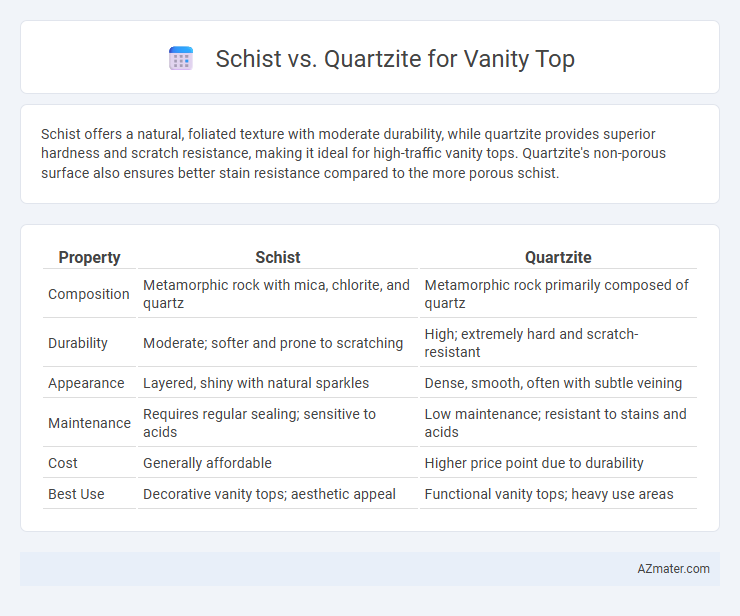Schist offers a natural, foliated texture with moderate durability, while quartzite provides superior hardness and scratch resistance, making it ideal for high-traffic vanity tops. Quartzite's non-porous surface also ensures better stain resistance compared to the more porous schist.
Table of Comparison
| Property | Schist | Quartzite |
|---|---|---|
| Composition | Metamorphic rock with mica, chlorite, and quartz | Metamorphic rock primarily composed of quartz |
| Durability | Moderate; softer and prone to scratching | High; extremely hard and scratch-resistant |
| Appearance | Layered, shiny with natural sparkles | Dense, smooth, often with subtle veining |
| Maintenance | Requires regular sealing; sensitive to acids | Low maintenance; resistant to stains and acids |
| Cost | Generally affordable | Higher price point due to durability |
| Best Use | Decorative vanity tops; aesthetic appeal | Functional vanity tops; heavy use areas |
Introduction to Schist and Quartzite Vanity Tops
Schist and quartzite are popular choices for vanity tops due to their durability and natural beauty. Schist is a metamorphic rock characterized by its foliated texture and visible mineral grains, offering unique patterns and a more rustic appearance. Quartzite, also a metamorphic rock, is denser and harder than schist, known for its smooth, polished surface and high resistance to scratches and heat, making it ideal for bathroom vanity tops.
Geological Composition: Schist vs Quartzite
Schist and quartzite differ significantly in geological composition, impacting their suitability for vanity tops. Schist is a metamorphic rock primarily composed of flaky minerals like mica, giving it a foliated texture with visible layers that may exhibit some weakness in durability. Quartzite forms from sandstone subjected to intense heat and pressure, resulting in an extremely hard, non-foliated rock composed mainly of interlocking quartz grains, offering superior resistance to scratches and stains for vanity surfaces.
Appearance and Aesthetic Differences
Schist vanity tops feature a shimmering, layered appearance with visible mineral flecks that create a textured, natural look ideal for rustic or eclectic designs. Quartzite exhibits a smoother, more uniform surface with subtle veining and a marble-like elegance, suitable for modern or classic aesthetics. The distinct contrast in luster and pattern complexity between schist and quartzite allows homeowners to choose between bold, dynamic visuals and refined, understated beauty.
Durability and Strength Comparison
Quartzite is significantly harder and more durable than schist, making it highly resistant to scratches, heat, and etching, which is ideal for vanity tops exposed to daily wear. Schist, characterized by its foliated texture and mineral composition, is softer and more prone to chipping or scratching, requiring more careful maintenance. Choosing quartzite ensures a long-lasting, strong surface that maintains its appearance under frequent use.
Maintenance and Cleaning Requirements
Schist vanity tops require regular sealing to prevent moisture absorption and staining, as their foliated texture can trap dirt and grime, making cleaning more demanding. Quartzite surfaces are more durable and less porous, allowing for easier maintenance with simple wiping using mild detergents and periodic resealing to preserve the stone's natural luster. Both materials benefit from avoiding acidic or abrasive cleaners to maintain their structural integrity and aesthetic appeal over time.
Cost Comparison: Schist vs Quartzite
Schist vanity tops generally cost less than quartzite, with prices ranging from $40 to $70 per square foot compared to quartzite's $80 to $150 per square foot. Quartzite commands a higher price due to its superior hardness, durability, and resistance to heat and scratches. Budget-conscious homeowners often prefer schist for its affordability, while those seeking premium quality and longevity invest in quartzite despite the higher cost.
Heat and Scratch Resistance
Quartzite offers superior heat and scratch resistance compared to schist, making it a durable choice for vanity tops exposed to hot styling tools and frequent use. Schist, composed of flaky mica minerals, is softer and more prone to scratches and heat damage, requiring careful maintenance. Homeowners seeking longevity and minimal upkeep often prefer quartzite for its robust, natural hardness and thermal stability in bathroom applications.
Installation Considerations
Schist requires careful sealing and skilled installation due to its foliated texture and natural cleavage planes, which can make cutting and shaping more challenging compared to quartzite. Quartzite's dense and hard composition allows for easier fabrication and durability, making it a preferred choice for vanity tops where long-term wear resistance is crucial. Both materials demand professional installation to ensure proper support and to avoid damage during handling and fitting.
Pros and Cons of Schist Vanity Tops
Schist vanity tops offer a unique, shimmering appearance due to their crystalline structure and natural mica content, making each piece visually distinct and luxurious. They provide good durability but are softer and more prone to scratches and etching compared to quartzite, requiring regular sealing and careful maintenance to preserve their beauty. While schist can add a warm, textured aesthetic to bathrooms, it may not be ideal for high-traffic or wet environments due to its porosity and susceptibility to staining.
Pros and Cons of Quartzite Vanity Tops
Quartzite vanity tops offer exceptional durability, resistance to heat, and a natural gloss that enhances bathroom aesthetics, making them a popular choice for high-traffic areas. Their dense composition minimizes porosity, reducing the risk of staining compared to schist, though occasional sealing is still recommended to maintain longevity. Quartzite's hardness can make fabrication and installation more challenging and costly, but its superior scratch resistance and elegant, marble-like appearance often justify the investment.

Infographic: Schist vs Quartzite for Vanity Top
 azmater.com
azmater.com